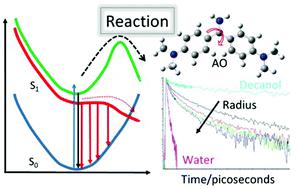当前位置:
X-MOL 学术
›
Chem. Soc. Rev.
›
论文详情
Our official English website, www.x-mol.net, welcomes your
feedback! (Note: you will need to create a separate account there.)
Altered relaxation dynamics of excited state reactions by confinement in reverse micelles probed by ultrafast fluorescence up-conversion
Chemical Society Reviews ( IF 40.4 ) Pub Date : 2021-08-19 , DOI: 10.1039/d1cs00516b Ismael A Heisler 1 , Stephen R Meech 2
Chemical Society Reviews ( IF 40.4 ) Pub Date : 2021-08-19 , DOI: 10.1039/d1cs00516b Ismael A Heisler 1 , Stephen R Meech 2
Affiliation

|
Chemical reactions in confined environments are important in areas as diverse as heterogenous catalysis, environmental chemistry and biochemistry, yet they are much less well understood than the equivalent reactions in either the gas phase or in free solution. The understanding of chemical reactions in solution was greatly enhanced by real time studies of model reactions, through ultrafast spectroscopy (especially when supported by molecular dynamics simulation). Here we review some of the efforts that have been made to adapt this approach to the investigation of reactions in confined media. Specifically, we review the application of ultrafast fluorescence spectroscopy to measure reaction dynamics in the nanoconfined water phase of reverse micelles, as a function of the droplet radius and the charge on the interface. Methods of measurement and modelling of the reactions are outlined. In all of the cases studied (which are focused on ultrafast intramolecular reactions) the effect of confinement was to suppress the reaction. Even in the largest micelles the result in the bulk aqueous phase was not usually recovered, suggesting an important role for specific interactions between reactant and environment, for example at the interface. There was no simple one-to-one correspondence with direct measures of the dynamics of the confined phase. Thus, understanding the effect of confinement on reaction rate appears to require not only knowledge of the dynamics of the reaction in solutions and the effect of confinement on the medium, but also of the interaction between reactant and confining medium.
中文翻译:

通过超快荧光上转换探测反胶束中的限制改变激发态反应的弛豫动力学
密闭环境中的化学反应在多相催化、环境化学和生物化学等多种领域都很重要,但与气相或游离溶液中的等效反应相比,它们的理解程度要低得多。通过对模型反应的实时研究,通过超快光谱(尤其是在分子动力学模拟的支持下),大大增强了对溶液中化学反应的理解。在这里,我们回顾了为使这种方法适用于对受限介质中的反应进行调查而做出的一些努力。具体而言,我们回顾了超快荧光光谱在测量反胶束纳米受限水相中反应动力学的应用,作为液滴半径和界面电荷的函数。概述了反应的测量和建模方法。在所有研究的案例中(专注于超快分子内反应),限制的作用是抑制反应。即使在最大的胶束中,主体水相中的结果通常也无法恢复,这表明反应物与环境之间的特定相互作用(例如在界面处)具有重要作用。与限制阶段动力学的直接测量没有简单的一一对应。因此,理解限制对反应速率的影响似乎不仅需要了解溶液中反应的动力学和限制对介质的影响,还需要了解反应物和限制介质之间的相互作用。在所有研究的案例中(专注于超快分子内反应),限制的作用是抑制反应。即使在最大的胶束中,主体水相中的结果通常也无法恢复,这表明反应物与环境之间的特定相互作用(例如在界面处)具有重要作用。与限制阶段动力学的直接测量没有简单的一一对应。因此,理解限制对反应速率的影响似乎不仅需要了解溶液中反应的动力学和限制对介质的影响,还需要了解反应物和限制介质之间的相互作用。在所有研究的案例中(专注于超快分子内反应),限制的作用是抑制反应。即使在最大的胶束中,主体水相中的结果通常也无法恢复,这表明反应物与环境之间的特定相互作用(例如在界面处)具有重要作用。与限制阶段动力学的直接测量没有简单的一一对应。因此,理解限制对反应速率的影响似乎不仅需要了解溶液中反应的动力学和限制对介质的影响,还需要了解反应物和限制介质之间的相互作用。即使在最大的胶束中,主体水相中的结果通常也无法恢复,这表明反应物与环境之间的特定相互作用(例如在界面处)具有重要作用。与限制阶段动力学的直接测量没有简单的一一对应。因此,理解限制对反应速率的影响似乎不仅需要了解溶液中反应的动力学和限制对介质的影响,还需要了解反应物和限制介质之间的相互作用。即使在最大的胶束中,主体水相中的结果通常也无法恢复,这表明反应物与环境之间的特定相互作用(例如在界面处)具有重要作用。与限制阶段动力学的直接测量没有简单的一一对应。因此,理解限制对反应速率的影响似乎不仅需要了解溶液中反应的动力学和限制对介质的影响,还需要了解反应物和限制介质之间的相互作用。
更新日期:2021-08-19
中文翻译:

通过超快荧光上转换探测反胶束中的限制改变激发态反应的弛豫动力学
密闭环境中的化学反应在多相催化、环境化学和生物化学等多种领域都很重要,但与气相或游离溶液中的等效反应相比,它们的理解程度要低得多。通过对模型反应的实时研究,通过超快光谱(尤其是在分子动力学模拟的支持下),大大增强了对溶液中化学反应的理解。在这里,我们回顾了为使这种方法适用于对受限介质中的反应进行调查而做出的一些努力。具体而言,我们回顾了超快荧光光谱在测量反胶束纳米受限水相中反应动力学的应用,作为液滴半径和界面电荷的函数。概述了反应的测量和建模方法。在所有研究的案例中(专注于超快分子内反应),限制的作用是抑制反应。即使在最大的胶束中,主体水相中的结果通常也无法恢复,这表明反应物与环境之间的特定相互作用(例如在界面处)具有重要作用。与限制阶段动力学的直接测量没有简单的一一对应。因此,理解限制对反应速率的影响似乎不仅需要了解溶液中反应的动力学和限制对介质的影响,还需要了解反应物和限制介质之间的相互作用。在所有研究的案例中(专注于超快分子内反应),限制的作用是抑制反应。即使在最大的胶束中,主体水相中的结果通常也无法恢复,这表明反应物与环境之间的特定相互作用(例如在界面处)具有重要作用。与限制阶段动力学的直接测量没有简单的一一对应。因此,理解限制对反应速率的影响似乎不仅需要了解溶液中反应的动力学和限制对介质的影响,还需要了解反应物和限制介质之间的相互作用。在所有研究的案例中(专注于超快分子内反应),限制的作用是抑制反应。即使在最大的胶束中,主体水相中的结果通常也无法恢复,这表明反应物与环境之间的特定相互作用(例如在界面处)具有重要作用。与限制阶段动力学的直接测量没有简单的一一对应。因此,理解限制对反应速率的影响似乎不仅需要了解溶液中反应的动力学和限制对介质的影响,还需要了解反应物和限制介质之间的相互作用。即使在最大的胶束中,主体水相中的结果通常也无法恢复,这表明反应物与环境之间的特定相互作用(例如在界面处)具有重要作用。与限制阶段动力学的直接测量没有简单的一一对应。因此,理解限制对反应速率的影响似乎不仅需要了解溶液中反应的动力学和限制对介质的影响,还需要了解反应物和限制介质之间的相互作用。即使在最大的胶束中,主体水相中的结果通常也无法恢复,这表明反应物与环境之间的特定相互作用(例如在界面处)具有重要作用。与限制阶段动力学的直接测量没有简单的一一对应。因此,理解限制对反应速率的影响似乎不仅需要了解溶液中反应的动力学和限制对介质的影响,还需要了解反应物和限制介质之间的相互作用。































 京公网安备 11010802027423号
京公网安备 11010802027423号